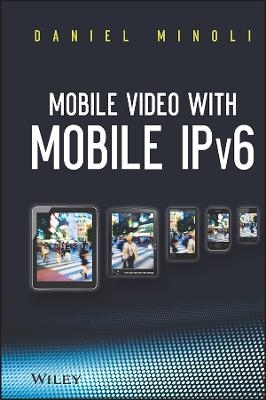
Mobile Video with Mobile IPv6
John Wiley & Sons Inc (Verlag)
978-1-118-35497-1 (ISBN)
- Lieferbar (Termin unbekannt)
- Versandkostenfrei innerhalb Deutschlands
- Auch auf Rechnung
- Verfügbarkeit in der Filiale vor Ort prüfen
- Artikel merken
DANIEL MINOLI has worked extensively in video engineering, design, and implementation at organizations including Telcordia Technologies (Bellcore), Stevens Institute of Technology, AT&T, and Gartner/DataPro. He taught at Stevens Institute of Technology, New York University, and Rutgers University. Mr. Minoli has authored columns for Computerworld, Network World, and Network Computing magazines. He has served as a technical Expert Witness and as an Advisor to high-tech Venture Capitalists
Preface xi
About the Author xiii
1 the Mobile User Environment: Smart Phones, Portable Media Players (PMPs), And Tablets 1
1.1 Introduction 1
1.2 Basic MIPv6 Operation 3
1.3 Entertainment Video Trends 10
1.4 Scope of Investigation 14
Appendix 1.1A: Statistics 15
Appendix 1.1B: Bibliography 16
References 18
2 IPv6 Basics 19
2.1 Overview and Motivations 19
2.2 Address Capabilities 23
2.2.1 IPv4 Addressing and Issues 23
2.2.2 IPv6 Address Space 24
2.3 IPv6 Protocol Overview 29
2.4 IPv6 Tunneling 37
2.5 IPsec in IPv6 40
2.6 Header Compression Schemes 40
2.7 Quality of Service In IPv6 44
2.8 Migration Strategies to IPv6 45
2.8.1 Technical Approaches 45
2.8.2 Residential Broadband Services in an IPv6 Environment 48
2.8.3 Deployment Opportunities 50
References 53
3 Mobile IPv6 Mechanisms 55
3.1 Overview 55
3.2 Protocol Details 63
3.2.1 Generic Mechanisms 63
3.2.2 New IPv6 Protocol, Message Types, and Destination Option 67
3.2.3 Modifications to IPv6 Neighbor Discovery 74
3.2.4 Requirements for Various IPv6 Nodes 74
3.2.5 Correspondent Node Operation 77
3.2.6 Home Agent Node Operation 82
3.2.7 Mobile Node Operation 82
3.2.8 Relationship to IPV4 Mobile IPv4 86
References 88
4 Advanced Features and Functions of MIPv6-Related Protocols—Part 1 89
4.1 Network Mobility Basic Support Protocol 89
4.2 Mobile IPv6 Fast Handovers 94
4.2.1 General Approach 94
4.2.2 3G Networks Approach 102
4.3 Multiple Care-of Addresses Registration 104
4.3.1 Overview 104
4.3.2 MIPv6 Extensions 105
4.4 Mobile Node Identifier Option for MIPv6 106
4.5 Mobile IPv6 Management Information Base 107
4.6 Sockets API For Mobile IPv6 109
References 111
5 Advanced Features and Functions of MIPv6-Related Protocols—Part 2 112
5.1 Dual-Stack MIPv6 112
5.2 Hierarchical Mobile IPv6 116
5.3 Flow Bindings in Mobile IPv6 and NEMO 119
5.4 Multihoming Approaches in NEMO 122
5.5 Bootstrapping MIPv6 Information 127
5.5.1 Basic Approach 128
5.5.2 Mobile IPv6 Bootstrapping in Split Scenario 128
5.6 Diameter Mobile IPv6 132
5.6.1 RFC 5447—Authentication Using AAA Infrastructures 132
5.6.2 RFC 5778—Authentication Using the Internet Key Exchange v2 134
5.7 Miscellaneous MIPv6 Capabilities 137
5.7.1 Mobile IPv6 Vendor Specific Option 137
5.7.2 MIPv6 Experimental Messages 137
5.7.3 Service Selection for MIPv6 138
References 139
6 Proxy Mobile IPv 6 141
6.1 Basic Proxy Mechanisms 144
6.1.1 Proxy Mobile IPv6 Protocol Overview 145
6.1.2 Signaling Call Flow 147
6.1.3 PM IPv6 Protocol Security 149
6.1.4 Messages 149
6.1.5 Operations 150
6.1.6 Summary 153
6.2 Transient Binding 153
6.2.1 Overview 153
6.2.2 Use of Transient Binding Cache Entries 155
6.3 Local Mobility Anchor Discovery 156
6.4 Localized Routing/Direct Routing 157
6.5 IPv4 Support for Proxy Mobile IPv6 159
6.5.1 Overview 159
6.5.2 IPv4 Home Address Mobility Support 162
6.5.3 IPv4 Transport Support 164
6.5.4 Localized Routing IPv4 Considerations 166
Appendix 6A: Network-Based Localized Mobility Management 167
6a.1 Background 167
6a.2 The Local Mobility Problem 168
References 171
7 Security Considerations For MIPv 6 173
7.1 Using IPsec to Protect MIPv6 Signaling Between Mobile Nodes and Home Agents 173
7.1.1 Payload Packets 174
7.1.2 Required Capabilities 175
7.2 MIPv6 Operation with IKEv2 and Revised IPsec Architecture 176
7.2.1 Packet Formats 176
7.2.2 Requirements 176
7.3 Securing Mobile IPv6 Route Optimization Using a Static Shared Key 181
7.4 Enhanced Security in Route Optimization 182
7.5 Mobile IPv6 and Firewalls 185
7.6 Non-IPsec Authentication Protocol For MIPv6 185
7.7 IP Address Location Privacy 186
7.8 Use of Secure Neighbor Discovery 187
7.9 Authentication, Authorization, and Accounting in MIPv6 188
7.10 Diameter Proxy Mobile IPv6 Approaches 188
References 189
8 Mobile Video and Video Streaming Services 190
8.1 Overview 190
8.1.1 Quality of Experience Aspects 195
8.1.2 QoS Aspects 204
8.2 3/4G Services and Video Applications 208
8.2.1 IETF IPv4/Mobile IPv4/IPv6 209
8.2.2 Universal Mobile Telecommunications System 209
8.2.3 Long Term Evolution 210
8.3 Streaming Protocols and Approaches 223
8.3.1 Streaming 223
8.3.2 Content Distribution Networks 234
8.3.3 P2P Networks 235
8.3.4 Cloud Computing 236
8.4 MIPv6 Support in CDMA2000/WiMAX Video Environments 238
8.5 Other Mobile Video Approaches 240
8.5.1 ETSI Digital Video Broadcast Handheld 240
8.5.2 Open Mobile Video Coalition Mobile Digital TV 245
References 252
Glossary 255
Index 273
| Verlagsort | New York |
|---|---|
| Sprache | englisch |
| Maße | 165 x 243 mm |
| Gewicht | 617 g |
| Themenwelt | Mathematik / Informatik ► Informatik ► Grafik / Design |
| Informatik ► Netzwerke ► TCP / IP und IPv6 | |
| Technik ► Elektrotechnik / Energietechnik | |
| Technik ► Nachrichtentechnik | |
| ISBN-10 | 1-118-35497-4 / 1118354974 |
| ISBN-13 | 978-1-118-35497-1 / 9781118354971 |
| Zustand | Neuware |
| Haben Sie eine Frage zum Produkt? |
aus dem Bereich


